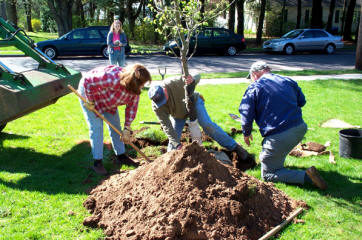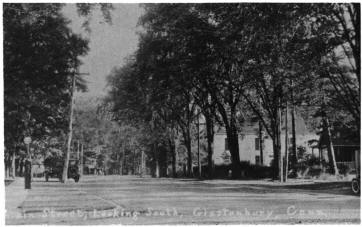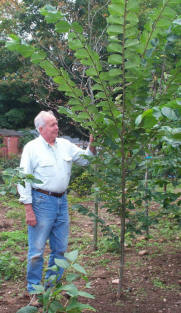|
American Elm Restoration |
Glastonbury's streets were once lined with hundreds
of graceful American Elms. During the 1920s and '30s Dutch
Elm Disease killed forty million of America's seventy
million Elms. Since that time universities and arboretums
have conducted research to develop disease-resistant
varieties. Several varieties of disease-resistant Elm are
now available.
Work to restore Elms to Glastonbury started
in 2002 with Glastonbury Parks and Recreation and the
Community Beautification Commission. GPIP has now taken up
this work with the goal of bringing American Elms back to
Glastonbury's streetscape. |
 |
A
Brief History of Elms
A special interest of GPIP is the restoration of
American Elms to our streets and public places. In the 19th
and early 20th centuries many towns and cities in the
Eastern United States were defined by their streets lined
with American Elms. New Haven, for example, got its moniker
"the Elm City" for that reason. |

Glastonbury Main St.
circa 1920 looking South
from the corner of Hebron Ave. |
In the 1920s Dutch Elm disease appeared in the U.S.
from Europe and began killing millions of American Elms. In
a few decades the streetscapes in countless Eastern U.S.
towns were radically altered by the loss of their graceful,
arching Elm trees. Glastonbury Partners in Planting would
like to recapture some of that lost beauty and grandeur by
restoring American Elms to Glastonbury's streets and public
places.
 Some
of the trees in the Town Tree Nursery are Valley Forge Elms,
a cultivar of American Elm. This cultivar is highly
resistant to the devastating Dutch Elm disease. Valley Forge
is the result of years of horticultural research to produce
a disease-resistant Elm which retains the classic look of
the American Elm. Some
of the trees in the Town Tree Nursery are Valley Forge Elms,
a cultivar of American Elm. This cultivar is highly
resistant to the devastating Dutch Elm disease. Valley Forge
is the result of years of horticultural research to produce
a disease-resistant Elm which retains the classic look of
the American Elm.
Another part of GPIP's mission is to educate the value of
biodiversity among flora. It was the practice of planting
only Elms that made the effects of Dutch Elm disease so
devastating. Had towns and cities planted Elms along with
other trees, the disease would not have spread so easily and
any loss of the Elms would not have had such an acute effect
on streetscapes. GPIP has taken this lesson to heart and
works to insure diversity of flora in its planting projects.
Please refer to the
Local
Partnerships page for the most recent American Elm
Restoration project. |
|
|

